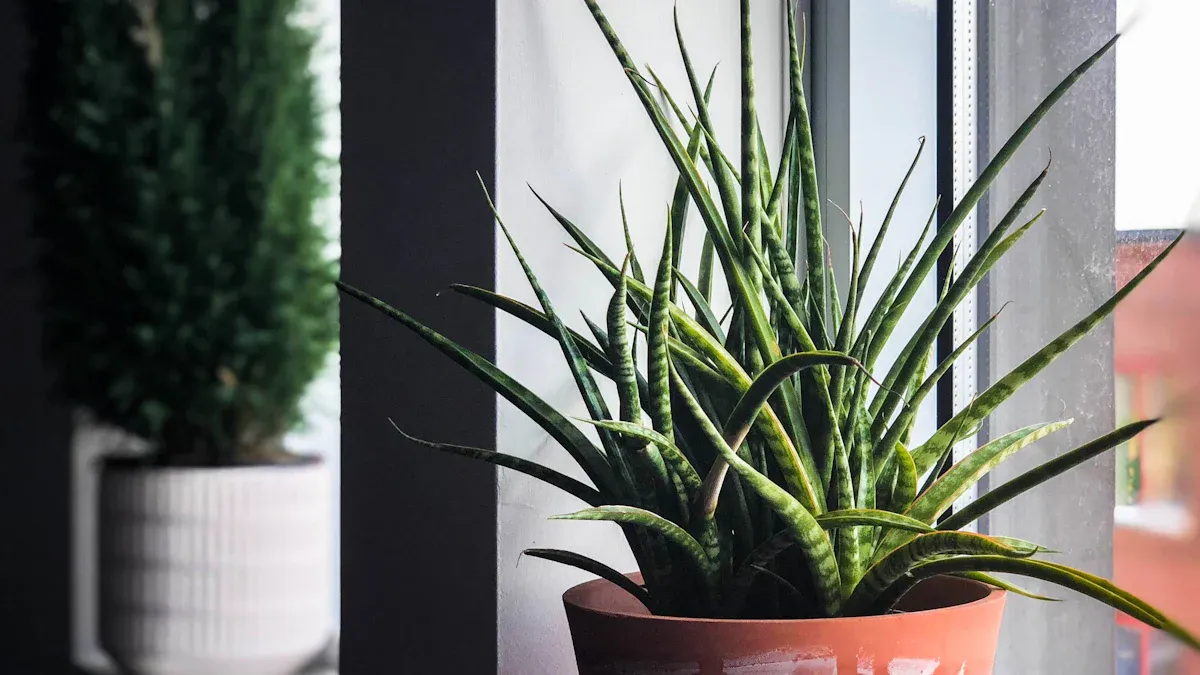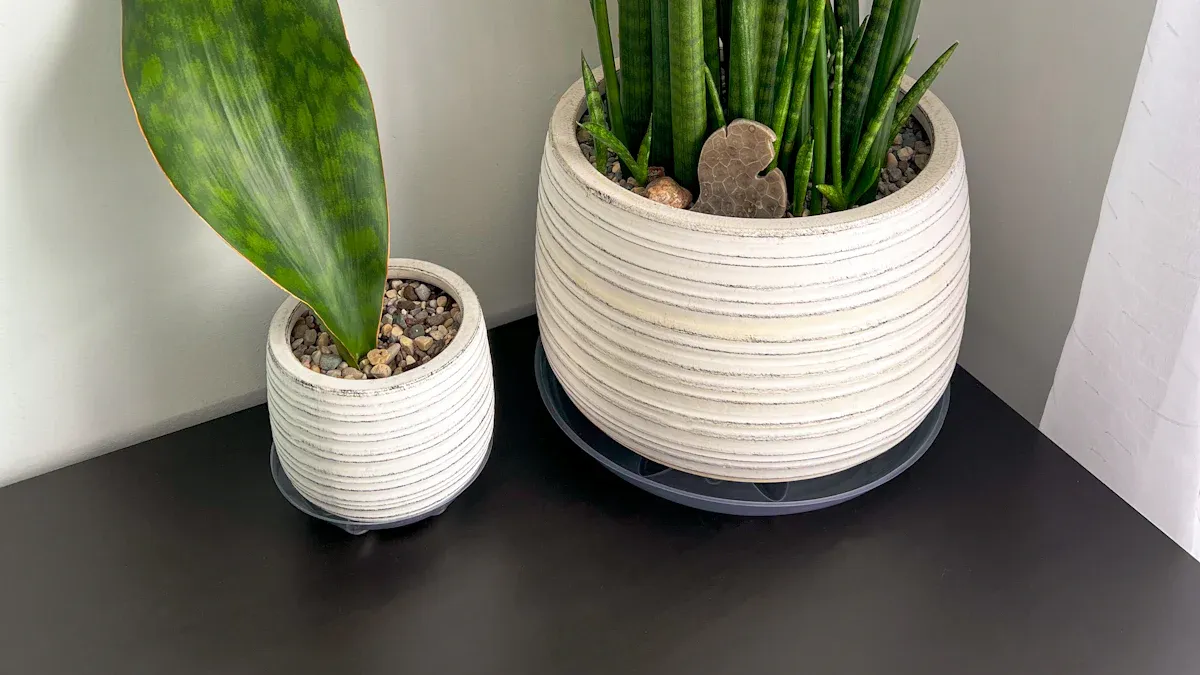
When selecting snake plant planters, you’ll want one that is slightly larger than the root ball—about 1-2 inches wider. This small adjustment makes a big difference. It helps the plant grow stronger, avoids waterlogging, and keeps the roots healthy. Experts recommend this pot size for optimal growth, so your snake plant thrives with minimal effort.
The Importance of Pot Size for Snake Plants

How Pot Size Affects Watering and Drainage
The size of the pot you choose plays a big role in how well your snake plant handles water. A pot that’s too large can hold excess water, which leads to soggy soil and unhappy roots. On the other hand, a pot that’s too small might not hold enough soil to retain moisture, causing the plant to dry out too quickly. Snake plant planters with proper drainage holes are essential to prevent water from pooling at the bottom. When you pick the right pot size—just 1-2 inches wider than the root ball—you’ll find it much easier to maintain the perfect balance of moisture. This helps your plant stay healthy and reduces the risk of overwatering.
Impact on Root Health and Growth
Snake plants thrive when their roots have just enough space to grow but not too much. They actually prefer being slightly root-bound, which means they don’t need a huge pot to flourish. A pot that’s about one-third larger than the root system is ideal for promoting healthy root growth. If you use pots for snake plants that are too big, the roots may struggle to absorb water efficiently, leading to poor growth. Smaller pots encourage the roots to spread evenly, creating a strong foundation for the plant. Choosing the right pot size ensures your snake plant stays happy and grows steadily over time.
Preventing Overcrowding and Root Rot
Overcrowding can become a problem if your snake plant outgrows its pot. When roots start tangling or pushing against the sides of the pot, they can’t absorb nutrients properly. This can lead to stunted growth or even root rot if the soil stays too wet. Using snake plant planters with recommended sizes prevents these issues. A slightly larger pot gives the roots room to breathe and grow without becoming cramped. Proper drainage also plays a key role here, as it keeps the soil from staying waterlogged. By choosing pots with the right size and drainage, you’ll protect your plant from common problems like overcrowding and root rot.
How to Pick the Best Snake Plant Pots
What Size Pot Works Best for Snake Plants
Choose a pot that’s just 1-2 inches wider than the root ball. This small size increase gives roots space to grow without too much soil. Snake plants like being a little root-bound, so avoid large pots. Bigger pots can hold extra water, which may cause root rot. Repotting into a slightly larger pot helps with drainage and keeps the plant healthy.
Tip: Don’t use pots much bigger than the current one. Too much space can make watering uneven, which harms your snake plant.
Why Drainage Holes Are Important
Pots with drainage holes are essential for snake plants. These holes let extra water escape, keeping the soil from getting too wet. Snake plants need well-draining soil, and drainage holes help maintain the right moisture level. Studies from UC IPM show poor drainage increases root rot risk, so always ensure proper drainage.
When repotting snake plant cuttings, wait until roots are about an inch long. Then, move them to a pot with drainage holes to avoid waterlogged soil.
Note: Always check for drainage holes before buying a pot. If your favorite pot doesn’t have them, drill holes or use a liner to improve drainage.
Picking the Right Pot Material (Terracotta, Plastic, Ceramic)
The material of your pot affects your snake plant’s health. Terracotta pots are great because they let air and water pass through. This helps the soil dry faster, which snake plants prefer. In colder weather, terracotta also prevents too much moisture, lowering root rot risk.
Plastic pots hold water longer, making them good for hot climates or if you forget to water often. Ceramic pots are a mix of both—they look nice, last long, and dry slower than terracotta.
Here’s a quick comparison of pot materials:
Planter Type | Description | Purchase Link |
|---|---|---|
Distressed Weathered Cement Planter | Made of cement stone with a distressed, weathered finish. | |
Natural Ceramic Faceted Planter | A good quality planter with a natural hue and faceted shape. | |
Natural Carved Wood Planter | Unique wooden planter carved from mango wood. | |
Copper Gravity Planter | Available in sizes from 4in to 8in, perfect for snake plants. | |
Gold Ceramic Indoor Pot | Ideal for snake plants, as they require minimal care. | |
Marrakesh Terracotta Planters | Hand-painted terracotta pots inspired by Moroccan textiles. | |
Minimal Stoneware Planter | Sleek design available in multiple sizes, good for drainage. |
Tip: Not sure which material to pick? Think about your climate and watering habits. Terracotta is great for dry areas, while plastic or ceramic pots hold moisture better.
Signs It’s Time to Repot Your Snake Plant

Repotting your snake plant isn’t something you need to do often, but knowing when it’s time can save your plant from common problems. Here are some signs to watch for:
Roots Growing Out of the Drainage Holes
If you notice roots poking through the drainage holes, it’s a clear signal your snake plant has outgrown its pot. This happens because the roots are searching for more space to expand. When this occurs, the plant becomes root-bound, which can stunt its growth and affect its ability to absorb water and nutrients. Snake plants typically need repotting every 5 to 6 years, but spring and summer are the best times to repot. Early fall works too if you live in a temperate climate.
Soil Dries Out Too Quickly
Does the soil seem to dry out faster than usual? This could mean the roots have taken over most of the space in the pot, leaving little room for soil to retain moisture. When this happens, watering becomes less effective, and your snake plant may start to show signs of stress. Fresh soil in a slightly larger pot can help restore balance and keep your plant thriving.
Plant Appears Top-Heavy or Unstable
A top-heavy or wobbly snake plant is another sign it’s time for a new pot. This often happens when the roots have grown too large for the pot, causing the plant to lose stability. Other indicators include cracked pots, bulging sides, or water running straight through the pot without being absorbed. If growth has slowed despite proper care, repotting can give your snake plant the space it needs to flourish.
Tip: When repotting, choose a pot that’s just 1-2 inches wider than the root ball. This prevents overwatering and keeps your plant healthy.
Tips for Repotting Snake Plants
Selecting the Right New Pot Size
Choosing the right pot size is crucial when repotting your snake plant. A pot that’s too large can lead to overwatering, while one that’s too small may restrict root growth. For seedlings, go with planters that are 4-6 inches in diameter. Mature plants do best in pots that are 10-12 inches wide. Always pick a pot that’s just one size larger than the current one. This ensures the roots have enough room to grow without sitting in excess soil, which can hold too much water.
Tip: Make sure the new planter has drainage holes to prevent water from pooling at the bottom. This small detail can save your plant from root rot.
Preparing the Pot and Soil for Repotting
Before you start, get your pot and soil ready. Use a well-draining soil mix to keep your snake plant happy. A good combination is 2/3 potting soil mixed with 1/3 perlite, pumice, or clay pebbles. Adding organic compost or worm compost enriches the soil and promotes healthy growth.
Choose a pot that’s slightly larger than the current one and double-check for drainage holes. If your favorite planter doesn’t have any, consider drilling holes or using a liner to improve drainage. Proper preparation ensures your plant adjusts smoothly to its new home.
Steps to Repot Your Snake Plant Safely
Repotting your snake plant doesn’t have to be tricky. Follow these steps to make the process stress-free:
Repot during spring or early summer when the plant is actively growing.
Gently remove the plant from its current pot. Loosen the root ball and shake off excess soil.
Inspect the roots. Trim any damaged or rotten parts to encourage healthy growth.
Fill the new pot with your prepared soil mix. Center the plant and add more soil around the roots.
Water thoroughly, ensuring the soil is moist but not soggy.
Place the plant in bright, indirect sunlight to help it settle into its new environment.
Care after repotting: Avoid overwatering during the first few weeks. Let the soil dry out between waterings to prevent stress on the roots.
Choosing the right pot for your snake plant makes a big difference. A pot slightly larger than the root ball with good drainage keeps your plant healthy. Regularly check for signs like overcrowded roots or unstable growth. With proper snake plant care, your plant will thrive and stay beautiful for years.
FAQ
How often should you repot a snake plant?
Snake plants usually need repotting every 5-6 years. If you notice overcrowded roots or unstable growth, it’s time to upgrade the pot.
Can you use a pot without drainage holes?
It’s not ideal. Snake plants need drainage holes to prevent water from pooling. If your pot lacks them, use a liner or drill holes.
What’s the best soil mix for snake plants?
A mix of 2/3 potting soil and 1/3 perlite or pumice works great. It ensures proper drainage and keeps your plant’s roots healthy.
Tip: Always check your plant’s roots during repotting. Healthy roots mean a thriving snake plant!
